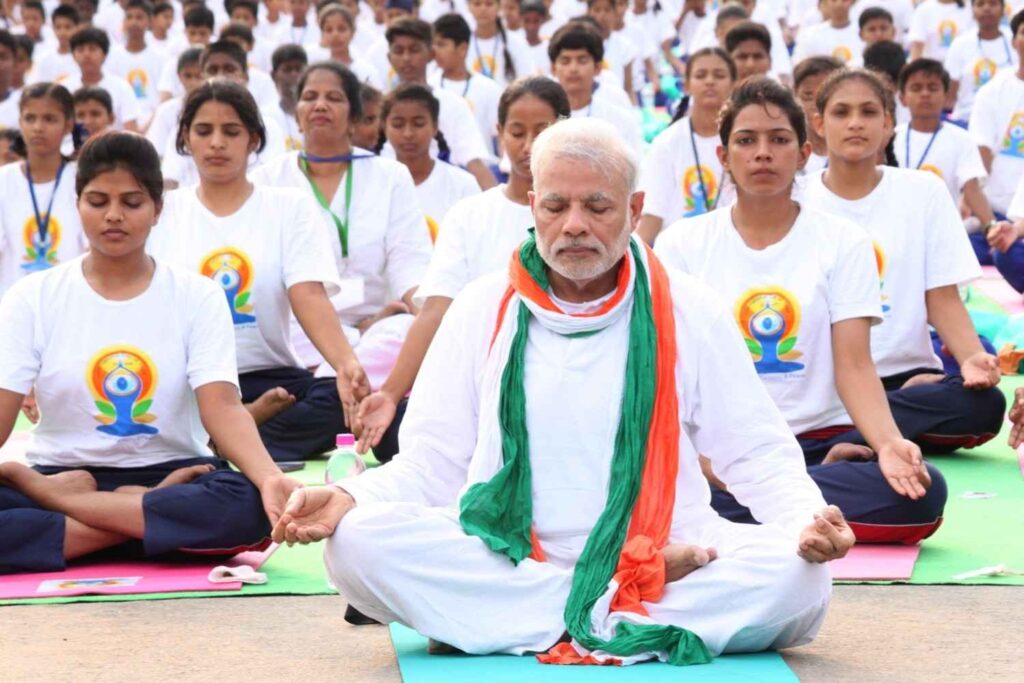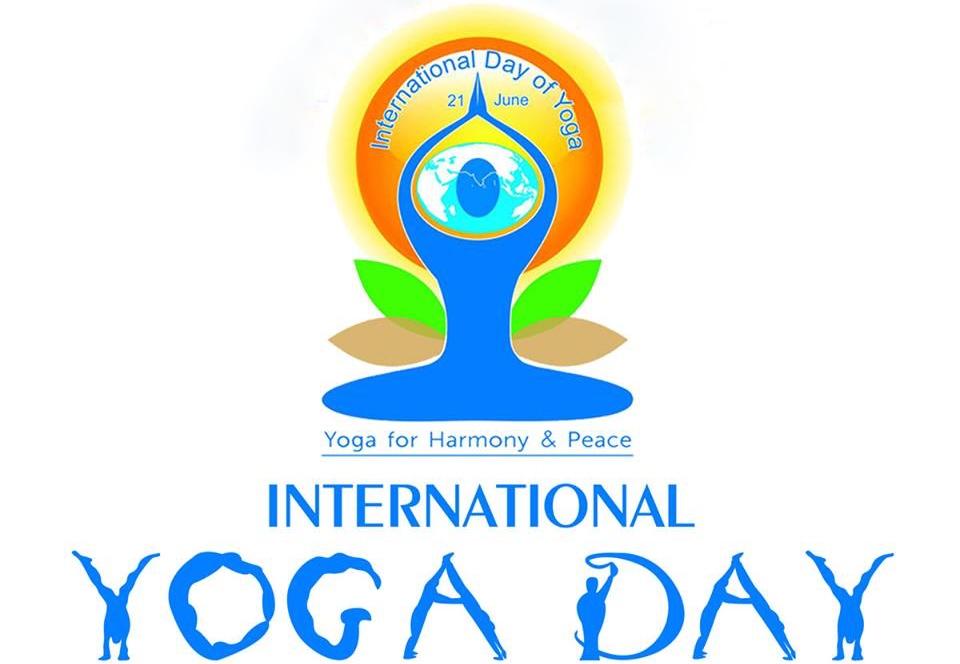Introduction
The International Day of Yoga, observed annually on June 21, is a testament to the ancient practice’s universal appeal. Recognizing its physical, mental, and spiritual advantages, the United Nations proclaimed this day in 20141. In this blog, we explore the origins, significance, and global celebrations of International Yoga Day.
Origins and Adoption of International Yoga Day

- Prime Minister Narendra Modi’s Vision:
- In September 2014, India’s Prime Minister, Narendra Modi, proposed the idea of an annual Day of Yoga during his speech at the United Nations General Assembly.
- He suggested that June 21, the summer solstice, be designated as the International Day of Yoga. This date holds significance as the longest day of the year in the Northern Hemisphere.
- UN Resolution and Global Acceptance:
- The United Nations adopted the draft resolution, officially recognizing June 21 as International Yoga Day.
- The resolution received widespread support, with 177 nations co-sponsoring it.
- Since then, people worldwide have celebrated this ancient practice on June 21.
- Yoga’s Universal Appeal:
- Yoga transcends borders, cultures, and religions.
- It promotes physical fitness, mental well-being, and spiritual growth.
- The essence of yoga lies in balance, mindfulness, and self-awareness.
In summary, International Yoga Day is a harmonious celebration of holistic wellness—a day when millions come together to embrace the transformative power of yoga.
Yoga’s Benefits
- Physical Well-Being:
- Enhanced Flexibility: Yoga asanas (postures) improve muscle flexibility and joint mobility.
- Strength and Balance: Regular practice strengthens muscles and enhances balance.
- Improved Posture: Yoga encourages proper alignment and spinal health.
- Mental Health:
- Stress Reduction: Mindful breathing and relaxation techniques reduce stress and anxiety.
- Emotional Resilience: Yoga fosters emotional stability and self-awareness.
- Better Sleep: Practicing yoga can lead to improved sleep quality.
- Spiritual Connection:
- Inner Peace: Yoga promotes a sense of calm and inner peace.
- Self-Reflection: Meditation and mindfulness deepen self-awareness.
- Harmony with Nature: Yoga aligns us with the natural world.
In summary, yoga is a holistic practice that benefits both body and mind. Whether you’re a beginner or an experienced yogi, embracing yoga can enhance your overall well-being.
Global Celebrations of International Yoga Day
- Events Across the World:
- On June 21, 2015, people from diverse backgrounds and cultures came together to celebrate International Yoga Day.
- Major cities worldwide hosted events, including New York, Paris, Beijing, and New Delhi.
- Public spaces, parks, and iconic landmarks served as venues for yoga sessions, workshops, and demonstrations.
- Millions Embracing Unity and Well-Being:
- Millions of participants joined in, emphasizing unity, harmony, and holistic well-being.
- Yoga practitioners of all ages, from children to seniors, actively engaged in various yoga poses and breathing exercises.
- The collective energy and shared purpose transcended borders, promoting a sense of global interconnectedness.
International Yoga Day continues to inspire people around the world, fostering physical health, mental balance, and a deeper connection to self and others.
Yoga Asanas and Practices

- Downward Dog (Adho Mukha Svanasana):
- Benefits:
- Stretches and strengthens the entire body.
- Relieves tension in the spine and hamstrings.
- Enhances blood circulation to the brain, promoting mental clarity.
- Calms the mind and reduces stress.
- Benefits:
- Tree Pose (Vrikshasana):
- Benefits:
- Improves balance and stability.
- Strengthens the legs, ankles, and core muscles.
- Cultivates focus and concentration.
- Symbolizes rootedness and connection to the earth.
- Benefits:
- Cobra Pose (Bhujangasana):
- Benefits:
- Opens the chest and stretches the spine.
- Strengthens the back muscles.
- Stimulates abdominal organs and improves digestion.
- Invokes a sense of vitality and courage.
- Benefits:
- Meditation and Pranayama Techniques:
- Benefits:
- Meditation calms the mind, reduces anxiety, and enhances self-awareness.
- Pranayama (breathing exercises) improves lung capacity, oxygenates the body, and balances energy.
- Techniques like Ujjayi (victorious breath) and Nadi Shodhana (alternate nostril breathing) promote overall well-being.
- Benefits:
Themes and Messages
- 2024 Theme: “Yoga for Self and Society”
- The chosen theme underscores the interconnectedness of individual well-being and societal harmony.
- It encourages practitioners to recognize that personal transformation through yoga contributes to a more balanced and compassionate world.
- By nurturing the self, we indirectly uplift our communities and promote global unity.
- Inspirational Quote:
- “Yoga is the journey of the self, through the self, to the self.” – The Bhagavad Gita.
- This timeless quote encapsulates the essence of yoga as a path of self-discovery, inner growth, and self-realization.
- It reminds us that yoga transcends physical postures; it is a profound exploration of our true nature.
Conclusion
International Yoga Day serves as a powerful reminder of our shared humanity and interconnectedness. Here’s why it matters:
- Bridging Cultures:
- Yoga transcends borders, languages, and traditions.
- It unites people from diverse backgrounds, emphasizing our common quest for well-being and inner peace.
- Promoting Well-Being:
- Yoga offers physical, mental, and emotional benefits.
- From increased flexibility to reduced stress, it enhances our overall quality of life.
- Fostering Unity:
- Practicing yoga together creates a sense of community.
- Whether in a park, a studio, or virtually, we connect through shared breath and intention.
- Embrace Yoga:
- Let’s make yoga a part of our daily lives.
- Whether you’re a beginner or an experienced practitioner, the path to harmony starts with that first mindful breath.
FAQ’s
Q. What is International Yoga Day?
A: International Yoga Day, also known as World Yoga Day, is celebrated annually on June 21st to promote the physical, mental, and spiritual benefits of practicing yoga.
Q. When was the first International Yoga Day celebrated?
A: The first International Yoga Day was celebrated on June 21, 2015.
Q. Why is International Yoga Day celebrated on June 21st?
A: June 21st is the longest day of the year in the Northern Hemisphere and has special significance in many parts of the world. The date was chosen to symbolize the summer solstice, which holds a unique importance in many cultures.
Q. Who proposed the idea of International Yoga Day?
A: The idea was proposed by Indian Prime Minister Narendra Modi during his speech at the United Nations General Assembly (UNGA) on September 27, 2014.
Q. What are the benefits of practicing yoga?
A: Yoga offers numerous benefits, including improved flexibility, strength, balance, and posture. It also helps reduce stress, anxiety, and depression and promotes overall mental and physical well-being.












